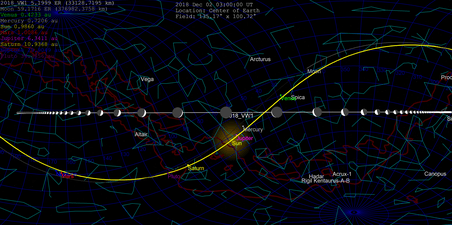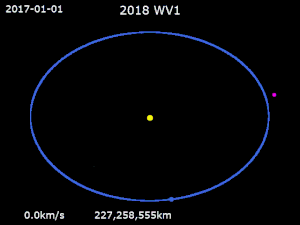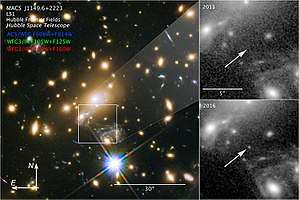2018 WV1
2018 WV1 is a very small asteroid and near-Earth object of the Apollo group that passed within 27,000 kilometers (17,000 miles) of the Earth's surface on 2 December 2018.[6][7] It was first observed on 29 November 2018 by Hannes Gröller with the Catalina Sky Survey at Catalina Station on Mount Bigelow, Arizona, in the United States.[1][3]
 2018 WV1's flyby trajectory | |
| Discovery [1] | |
|---|---|
| Discovered by | CSS H. Groeller[2][3] |
| Discovery site | Catalina Station |
| Discovery date | 29 November 2018 (first observed only) |
| Designations | |
| 2018 WV1 | |
| NEO · Apollo [1][4] Earth crosser | |
| Orbital characteristics [4] | |
| Epoch 27 April 2019 (JD 2458600.5) | |
| Uncertainty parameter 2 | |
| Observation arc | 13 days |
| Aphelion | 1.1021 AU |
| Perihelion | 0.9767 AU |
| 1.0394 AU | |
| Eccentricity | 0.0603 |
| 1.06 yr (387 d) | |
| 169.02° | |
| 0° 55m 48.36s / day | |
| Inclination | 1.6525° |
| 246.42° | |
| 145.89° | |
| Earth MOID | 0.039 LD (12900 km) |
| Physical characteristics | |
Mean diameter | 4 m (assumed)[5] |
| 30.145[5] 30.183[4] 30.2[1] | |
Orbit
2018 WV1 orbits the Sun at a distance of 0.98–1.10 AU once every 387 days (semi-major axis of 1.04 AU). Its orbit has an eccentricity of 0.06 and an inclination of 2° with respect to the ecliptic.[4]
As an Apollo asteroid with an orbital period slightly larger than that of the Earth, its orbit is very similar to that of the Earth, indicating that the object is a piece of lunar ejecta, a fragment of the Moon that was ejected into space when a larger asteroid hit the Moon a long time ago.[7]
2018 flyby
On 2 December 2018, the asteroid passed about 33,000 km (21,000 mi) from Earth, traveling 5.2 kilometres per second (3.2 mi/s) relative to Earth and briefly reaching apparent magnitude 17.[4] This was the third-closest approach by an asteroid in 2018, and the 70th asteroid of the year that passed within 1 lunar distance of Earth.[6] Its absolute magnitude of 30.1 indicates a diameter between 2.5 and 5.6 metres.[7]
2018 WV1 remains inside the Earth's sphere of influence from 27 November till 7 December 2018.[8] During the flyby, its orbital period changes from 1.13 to 1.06 years.
At the time of its discovery, 2018 WV1 had a 2% chance to hit Earth in early December 2018. The possibility of impact was ruled out soon after, as more data became available.[7]
Other flybys
2018 WV1 will pass within 0.38 AU (57,000,000 km) of Earth in December 2019.[4]
With a short observation arc of 1.69 days, the asteroid is on the Sentry risk list, with a probability of 1 in 11,000 for an impact between 2085 and 2118.[9]
Flyby gallery
 Its closest approach will be between the earth and sun, so can't be observed.
Its closest approach will be between the earth and sun, so can't be observed. Animation of 2018 WV1 orbit around Earth
Animation of 2018 WV1 orbit around Earth
Moon · Earth · 2018 WV1 Animation of 2018 WV1 orbit around Sun from 2017 to 2021
Animation of 2018 WV1 orbit around Sun from 2017 to 2021
Sun · Earth · 2018 WV1
References
- "2018 WV1". Minor Planet Center. Retrieved 7 January 2019.
- "MPEC 2018-W81 : 2018 WV1". Minor Planet Center. 30 November 2018. Retrieved 1 December 2018.
- "A small rock discovered this week by our observer Hannes Gröller". Catalina Sky Survey. 1 December 2018. Retrieved 1 December 2018.
- "JPL Small-Body Database Browser: (2018 WV1)" (2018-12-12 last obs.). Jet Propulsion Laboratory. Retrieved 7 January 2019.
- "2018WV1 physical properties". European Space Agency. 1 December 2018. Retrieved 1 December 2018.
- "Asteroid 2018 WV1 will flyby Earth at a very close distance of 0.09 LD on December 2, 2018". The Watchers. 30 November 2018. Retrieved 1 December 2018.
- Byrd, D. (1 December 2018). "Small asteroid to sweep close this weekend". earthsky.org. Retrieved 1 December 2018.
- "Earth's Busy Neighborhood". hohmanntransfer.com. Asteroid/Comet Connection. 1 December 2018. Retrieved 2 December 2018.
- "2018 WV1 -- Earth Impact Risk Summary". JPL. 30 November 2018. Retrieved 1 December 2018.
External links
- List Of Apollo Minor Planets (by designation), Minor Planet Center
- 2018 WV1 at NeoDyS-2, Near Earth Objects—Dynamic Site
- Ephemeris · Obs prediction · Orbital info · MOID · Proper elements · Obs info · Close · Physical info · NEOCC
- 2018 WV1 at the JPL Small-Body Database

